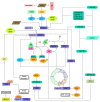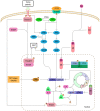CDK4/6 inhibitor resistance mechanisms and treatment strategies (Review)
- PMID: 36043521
- PMCID: PMC9448295
- DOI: 10.3892/ijmm.2022.5184
CDK4/6 inhibitor resistance mechanisms and treatment strategies (Review)
Abstract
In recent years, the incidence rate of breast cancer has increased year by year, and it has become a major threat to the health of women globally. Among all breast cancer subtypes, the hormone receptor (HR)+/human epidermal growth factor receptor 2 (HER2)‑ luminal subtype breast cancer is the most common form of breast cancer. Cyclin‑dependent kinase 4 and 6 (CDK4/6) inhibitors, the hotspots in the field of targeted therapy for breast cancer, have proved to exhibit a good effect on patients with HR+/HER2‑ breast cancer in a number of clinical trials, but the problem of drug resistance is inevitable. At present, three specific CDK4/6 inhibitors (palbociclib, ribociclib and abemaciclib) have been approved by the USA Food and Drug Administration for the first‑line treatment of HR+/HER2‑ breast cancer. The drug resistance mechanisms of CDK4/6 inhibitors can be divided into cell cycle‑specific resistance and cell cycle non‑specific resistance. With the discovery of the drug resistance mechanism of CDK4/6 inhibitors, various targeted strategies have been proposed. The present review mainly discusses the mechanism of CDK4/6 inhibitors, drug resistance mechanisms and treatment strategies after resistance.
Keywords: CDK4/6; breast cancer; drug resistance; mechanisms; strategies.
Conflict of interest statement
The authors declare that they have no competing interests.
Figures





References
Publication types
MeSH terms
Substances
LinkOut - more resources
Full Text Sources
Medical
Research Materials
Miscellaneous

